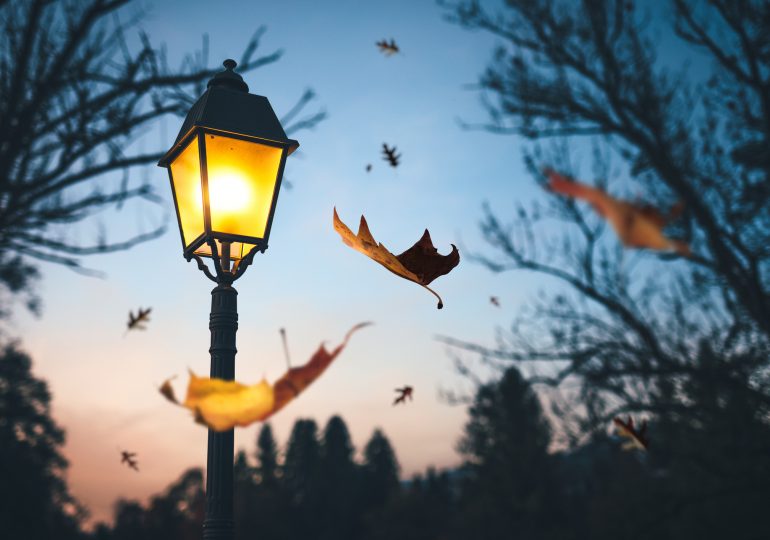The end of daylight saving time is an abrupt shift: from one day to the next, the day is blunted. The change is usually met with initial relief at getting an extra hour of sleep, and then a lot of grumpiness the following week, punctuated by remarks of “It gets dark out so early now” and “It’s only 6:30 p.m.!? It feels like 9 p.m.!” But rather than responding passively, we can actively anticipate, and even welcome, the end of daylight saving time.
One of the biggest problems with the end of daylight saving time is how, like so much of winter, it sneaks up on us. Now that our phones update the time automatically, it’s even possible to sleep through the shift without realizing: while writing my book, How to Winter, I visited a local coffee shop the morning after the clock change. When I asked the barista if she enjoyed her extra hour of sleep, she replied, “Oh, is that why my cat woke up early this morning?” Our schedules don’t accommodate it: we don’t end work or school earlier or adjust our routines. We are blindsided by the darkness, shocked at how tired we feel, frustrated that the world around us has shifted suddenly and unnaturally.
It doesn’t have to be this way.
The first step of embracing the clock change is to anticipate the transition. Mark it on the calendar in advance, so it becomes part of the rhythm of fall. Acknowledge that the end of daylight saving time might have consequences. It’s unreasonable to think that a sudden one-hour change in daylight won’t affect us physically or emotionally; at the very least, this abrupt shift disrupts our circadian rhythms, messing with our sleep schedules in a way similar to jet lag. Light also helps us feel alert and improves cognition, which boosts our mood, so losing an hour of afternoon luminosity can have a mild depressant effect, especially when we’re not prepared for it. We may have less energy in the week after the end of daylight saving time, have our routines disrupted, and feel less like socializing or being active. We can expect that the week post- clock-change will be a transition week: an in‑between period bringing us from one season to another.
[time-brightcove not-tgx=”true”]
Read More: Daylight Saving Time Is the Worst
To facilitate this transition, and to give myself something comforting to look forward to, I plan in advance for a lighter week after the end of daylight saving time, scaling back on unnecessary meetings and appointments. I know that I’ll feel more tired, so I try not to overload myself. Not all of us are able to adjust our schedules significantly, but if you can reduce meetings or after-work commitments to enable more flexibility to listen to your physical and emotional needs during this time, it can feel wonderful. If you have kids, it can be especially helpful to lighten their schedules this week: the change in daylight can make sleep schedules wonky and throw things out of whack for them too.
Anticipating this transition is an opportunity to practice living with nature rather than fighting it. Many people bemoan the change in daylight, complaining about feeling tired. Rather than seeing this as a problem, it can be a week to catch up on rest. If you’re sleepy, you can have a cozy night in or allow yourself to go to bed earlier. If you go to bed earlier and still wake up at your normal time—great, you got more sleep than usual, and your body must have needed it! If you go to bed and wake up earlier than usual, then you’re adjusting to the sun’s new schedule and you have more time for your morning.
For some people—especially those with kids, working long hours, or with other caregiving responsibilities—getting more sleep can be easier said than done. (While this is true for many, it is painful to live in a world where a few extra hours of sleep is viewed as a luxury only for the privileged.) But making a little extra space for rest during this transition—whether sleeping more or simply slowing down a bit—can sustain us. Taking a long bath, cooking a comforting meal, or rewatching a favorite movie are all low-stimulation ways to replenish ourselves this week.
We can also reframe the feeling of “It’s only six o’clock!?” as a gift: How often do you realize that it’s earlier than you thought, and the night is still young? I relish the clock change when I can think it’s 9 p.m., realize it’s only 7 p.m., and have time ahead for leisure or productivity and still get to bed early. The feeling of more evening time is a bounty of the clock change, and seeing this as a boon, rather than a punishment, changes the experience entirely.
Many people dislike the early darkness that follows the end of daylight saving time. To counteract this, we can give ourselves things to look forward to. In advance of the time change, try readying supplies for a sunset ritual to mark the end of the day: enjoying a cup of coffee or a pot of tea, lighting candles, or putting on fuzzy socks. Those of us commuting as it gets dark can enjoy the sunset colors on our way home from work or can take a sunset or early dusk walk after the workday ends. We can enjoy the darkness: movie nights can begin at six p.m., dinner can be by candlelight, evening workouts and showers can use soft lighting, these activities made cozy by the lack of sun. If we clear our schedules of unnecessary obligations during the transition week, it makes room for special activities. For those needing downtime, plan a special night at home: a new video game or book, favorite takeout, or family slumber party in the living room. For those who need to socialize to energize, meet friends for dinner or have people over for game night. The key is to make it special: whether by yourself or with family or friends, make it a real plan and give yourself something to anticipate. Call it your Daylight Saving Time Activity or your Darkness Celebration. When done successfully, you may even find yourself counting down the days to the shift in daylight. And making the end of daylight saving time fun is a practice in deliberately and playfully meeting oncoming challenges. Acknowledging and preparing for an approaching change gives us the chance to make it our own.
The end of daylight saving time is a practice run for the season. Those first two weeks after the time shift are a microcosm of winter: as we’re plunged into darkness, we’re forced to confront our thoughts and feelings about winter—good or bad. How you respond to the clock change can set the tone for the following months. By anticipating it, making space for the transition, and finding ways to make the shorter days feel special, we can make the shift easier and more fun and also start to see—in a small but meaningful way— how possible it is to transform our experience of winter darkness, putting us on a path to enjoying the season to come.
From HOW TO WINTER by Kari Leibowitz, PhD, published by Penguin Life, an imprint of Penguin Publishing Group, a division of Penguin Random House LLC. Copyright © 2024 by Kari Leibowitz.
Leave a comment








